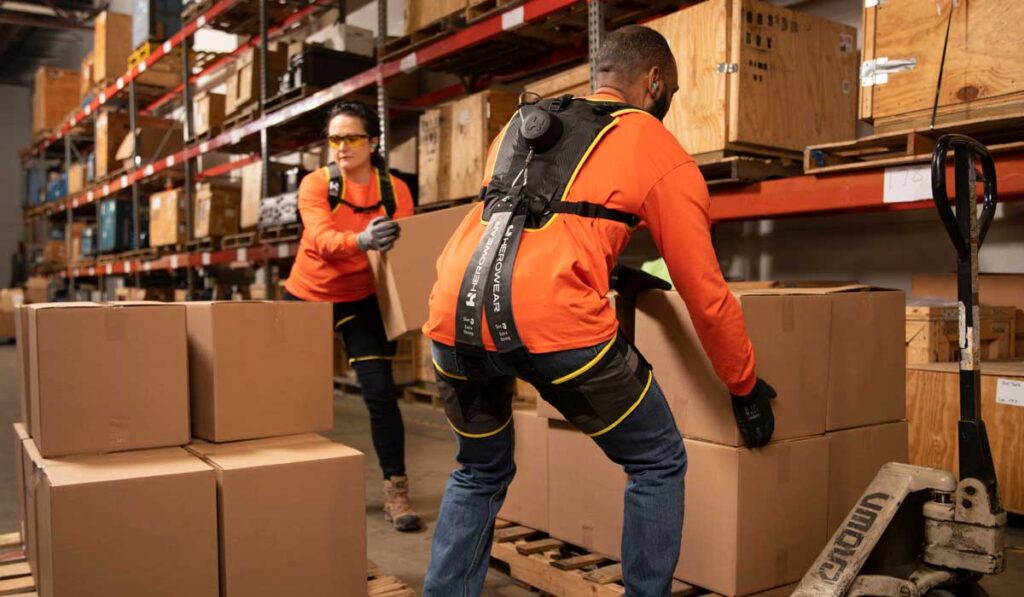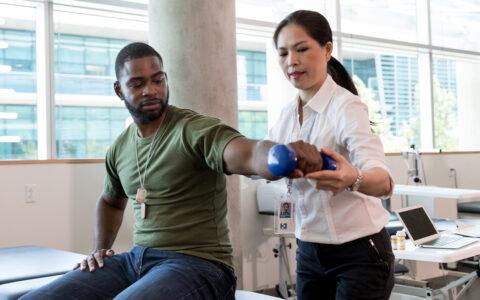Karl Zelik, Ph.D., an associate professor of physical medicine and rehabilitation at Vanderbilt University Medical Center and co-director of the Center for Rehabilitation Engineering and Assistive Technology at Vanderbilt, spent the last five years working on a system to reduce work-related back injuries.
The technology he pioneered at Vanderbilt has led to the HeroWear Apex exosuit, a wearable lift-assist device now in use in multiple industries at over 100 locations in 10 countries.
Extended field studies with dozens of workers in logistics, agriculture and construction have yielded overwhelmingly encouraging data, with workers reporting reduced discomfort and less fatigue.
“The primary goal of back-assist exosuits is to provide a practical, wearable device to reduce the risk of back injury to a wide variety of workers,” said Aaron Yang, M.D., medical director of outpatient services at Vanderbilt Stallworth Rehabilitation Hospital, and co-investigator on the Vanderbilt research. “For people in jobs that require prolonged bending or repetitive lifting, exosuits have exciting potential to reduce back strain, muscle fatigue, and injury risks.”
“Our mission was to create a device that is lightweight, form-fitting, and easy-to-use, that workers can wear comfortably and only engage assistance when they need back relief. Otherwise, the Apex just blends in, like another piece of clothing,” said Zelik, who is also co-founder and chief scientific officer at HeroWear.
The Need for a Better Assistive Device
Back injuries account for about 20 percent of all workplace injuries. Previous efforts to assist workers through postural-assist devices, such as back belts, have made little headway. As long ago as 1996, the National Institute for Occupational Safety and Health determined that the use of lumbar back belts lacked scientific evidence.
Exoskeletons/exosuits are a different type of wearable device that substantially reduces musculoskeletal forces, a key injury risk factor. However, Zelik says previous devices have been costly and too heavy, bulky and cumbersome for people to want to use on a regular basis.
The Innovative Exosuit
The HeroWear Apex exosuit is a textile-based, non-powered suit that weighs under four pounds. It enables 75 pounds of load to be relieved from the user’s back each time they bend or lift. This translates to a 29 to 47 percent reduction in back muscle fatigue.
The exosuit works by using elastic bands that span along the back, connecting a textile shoulder harness to sleeves that wrap around each thigh. “When a person bends down, some of the force is routed through the elastic bands rather than through the person’s own back muscles, relieving strain off the back muscles and spine,” Zelik explained. “During lifting, as a person stands back up, the potential energy stored in the elastic bands is released, which helps the person spring up.”
“Our mission was to create a device that is lightweight, form-fitting, and easy-to-use, that workers can wear comfortably and only engage assistance when they need back relief.
“Recent enhancements include a clutch mechanism that empowers the wearer to quickly engage or disengage assistance by flipping a small switch on their shoulder, as well as customized fits for men and women,” Zelik said. “We are the first exoskeleton/exosuit developers in the world to do that.”

Success in the Workplace
The Vanderbilt team published the foundational scientific studies behind the exosuit, which explain the musculoskeletal biomechanics underlying the device.
Vanderbilt and spin-off company HeroWear then worked together to evaluate early prototypes on warehouse workers. HeroWear recently released data on extended field studies with dozens of workers in various industries who each wore the Apex exosuit daily for 4-10 weeks.
Workers reported an average reduction in work-related effort of 28 percent when wearing the Apex exosuit, and a reduction in work-related discomfort of 23-40 percent, not only in the back but also in the shoulders and knees. In interviews with workers, wearers discussed the positive impact the exosuit has had both on the job and at home from being less sore and fatigued.
Expanding Exosuit Impact
Zelik is looking ahead to other product development, recently completing proof-of-concept work on an extensible exosuit with a dual-mode design to assist the back and other body segments.
“There are promising opportunities to apply this extensible exosuit to assist heavy-lifting, to further enhance user comfort and to address the unique needs of last-mile delivery drivers,” he said.





